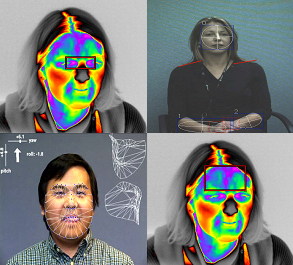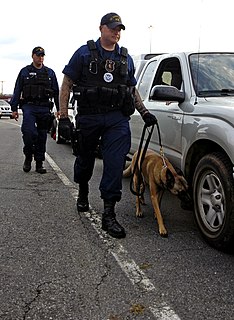
The United States Department of Homeland Security (DHS) is a cabinet department of the U.S. federal government with responsibilities in public security, roughly comparable to the interior or home ministries of other countries. Its stated missions involve anti-terrorism, border security, immigration and customs, cyber security, and disaster prevention and management. It was created in November 2002 in response to 9/11 and is the youngest U.S. cabinet department.

Airport security refers to the techniques and methods used in an attempt to protect passengers, staff, aircraft, and airport property from accidental/malicious harm, crime, terrorism, and other threats.

Biometrics is the technical term for body measurements and calculations. It refers to metrics related to human characteristics . Biometrics authentication is used in computer science as a form of identification and access control. It is also used to identify individuals in groups that are under surveillance.

The United States Naval Criminal Investigative Service (NCIS) is the primary law enforcement agency of the U.S. Department of the Navy. Its primary function is to investigate criminal activities involving the U.S. Navy and U.S. Marine Corps, though its broad mandate includes national security, counterintelligence, counter-terrorism, cyber warfare, and the protection of U.S. naval assets worldwide. NCIS is the successor organization to the former Naval Investigative Service (NIS), which was established by the Office of Naval Intelligence after the Second World War.

The Federal Protective Service (FPS) is the uniformed security police division of the United States Department of Homeland Security. FPS is "the federal agency charged with protecting and delivering integrated law enforcement and security services to facilities owned or leased by the General Services Administration (GSA)"—over 9,000 buildings—and their occupants.

The Homeland Security Act (HSA) of 2002, was introduced in the aftermath of the September 11 attacks and subsequent mailings of anthrax spores. The HSA was cosponsored by 118 members of Congress. The act passed the U.S. Senate by a vote of 90-9, with one Senator not voting. It was signed into law by President George W. Bush in November 2002.
An explosives trace-detection portal machine, also known as a trace portal machine and commonly known as a puffer machine, is a security device that seeks to detect explosives and illegal drugs at airports and other sensitive facilities as a part of airport security screening. The machines are intended as a secondary screening device, used as a complement to, rather than a substitute for, traditional X-ray machines.

The Border and Maritime Security Division (BMD) is a division of the Science and Technology Directorate of the United States Department of Homeland Security. Within the Homeland Security Advanced Research Projects Agency, BMD develops tools and technologies that improve the security of the United States's land borders and waterways.

Project Hostile Intent is an ongoing project of the United States Department of Homeland Security, Human Factors Division. It has been renamed to Future Attribute Screening Technology. This project comes under the Social and Behavioral Research (SBR) Program, one of the three broad program areas within the Science and Technology (S&T) Directorate of the Department of Homeland Security (DHS) that "sponsors research to inform, develop, and test tools and methodologies to assess terrorist threats, understand terrorism, and improve national security".

The Explosives Division (EXD) is a division of the Science and Technology Directorate of the United States Department of Homeland Security. Within the Homeland Security Advanced Research Projects Agency, EXD develops technologies needed to detect, interdict, and lessen the effect of non-nuclear explosives used by terrorists against mass transit, civil aviation, and critical infrastructure.

The Chemical and Biological Defense Division (CBD) is a division of the Science and Technology Directorate of the United States Department of Homeland Security. Within the Homeland Security Advanced Research Projects Agency, CBD develops technologies to increase the United States's preparedness and protect key national infrastructure against chemical, biological, and agricultural threats and disasters through improved threat awareness and advanced surveillance, detection, and protective countermeasures.
According to the DHS S&T website, the Command, Control, and Interoperability Division was a unit of the DHS Science and Technology Directorate which "develops interoperable communication standards and protocols for emergency responders, cyber security tools for protecting the integrity of the Internet, and automated capabilities to recognize and analyze potential threats."

The Infrastructure Protection and Disaster Management Division (IDD) is a division of the Science and Technology Directorate of the United States Department of Homeland Security. Within the Homeland Security Advanced Research Projects Agency, IDD develops technologies to improve and increase the United States' strategic preparedness response to natural and man-made threats through situational awareness, emergency response capabilities, and critical infrastructure protection.
The concept of border security in the United States of America shares a complex relationship with the persistent threat of terrorism. Border security includes the protection of land borders, ports, and airports. The relationship is unique in the sense that the federal government must constantly reevaluate and tweak its border security policy to address the perceived threats posed to the United States through the form of human terrorism or the smuggling and detonation of a weapon of mass destruction.

Future Attribute Screening Technology (FAST) is a program created by the Department of Homeland Security. It was originally titled Project Hostile Intent. The purpose is to detect "Mal Intent" by screening people for "psychological and physiological indicators" in a "Mobile Screening Laboratory".

The Under Secretary of Homeland Security for Science and Technology is a high level civilian official in the United States Department of Homeland Security. The Under Secretary, as head of the Science and Technology Directorate at DHS, is the principal staff assistant and adviser to both the Secretary of Homeland Security and the Deputy Secretary of Homeland Security for all DHS technological research.

A Visible Intermodal Prevention and Response team, sometimes Visible Intermodal Protection and Response (VIPR) is a Transportation Security Administration program. Various government sources have differing descriptions of VIPR's exact mission. It is specifically authorized by 6 U.S.C. § 1112 which says that the program is to "augment the security of any mode of transportation at any location within the United States". Authority for the program is under the Secretary of Homeland Security. The program falls under TSA's Office of Law Enforcement/Federal Air Marshal Service. TSA OLE/FAMS shares responsibility for the program with the Office of Security Operations and Transportation Sector Network Management.
National Urban Security Technology Laboratory is a United States government-owned, government-operated laboratory, part of the Department of Homeland Security (DHS) Science & Technology Directorate. It is located in the Federal Office Building at 201 Varick Street in the Hudson Square neighborhood, Manhattan, New York.

The Cyber Security Division (CSD) is a division of the Science and Technology Directorate of the United States Department of Homeland Security (DHS). Within the Homeland Security Advanced Research Projects Agency, CSD develops technologies to enhance the security and resilience of the United States' critical information infrastructure from acts of terrorism. S&T supports DHS component operational and critical infrastructure protections, including the finance, energy, and public utility sectors, as well as the first responder community.
Airport privacy involves the right of personal privacy for passengers when it comes to screening procedures, surveillance, and personal data being stored at airports. This practice intertwines airport security measures and privacy specifically the advancement of security measures following the 9/11 attacks in the United States and other global terrorist attacks. Several terrorist attacks, such as 9/11, have led airports all over the world to look to the advancement of new technology such as body and baggage screening, detection dogs, facial recognition, and the use of biometrics in electronic passports. Amidst the introduction of new technology and security measures in airports and the growing rates of travelers there has been a rise of risk and concern in privacy.










